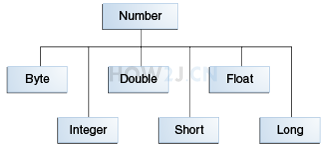Basic types of boxing and unboxing in Java
Step 1: Encapsulation classes
All basic types have corresponding class types
For example, the class corresponding to int is Integer.
This class is called encapsulation class.
package digit;
public class TestNumber {
public static void main(String[] args) {
int i = 5;
//Convert a basic type of variable to an Integer object
Integer it = new Integer(i);
//Convert an Integer object to a basic type of int
int i2 = it.intValue();
}
}Step 2: Number class
Digital encapsulation classes include
Byte,Short,Integer,Long,Float,Double
These classes are subclasses of the abstract class Number
package digit;
public class TestNumber {
public static void main(String[] args) {
int i = 5;
Integer it = new Integer(i);
//Integer is a subclass of Number, so print true
System.out.println(it instanceof Number);
}
}Step 3: Basic type encapsulation classes
package digit;
public class TestNumber {
public static void main(String[] args) {
int i = 5;
//Basic type to encapsulation type
Integer it = new Integer(i);
}
}Step 4: Packaging classes to basic types
package digit;
public class TestNumber {
public static void main(String[] args) {
int i = 5;
//Basic type to encapsulation type
Integer it = new Integer(i);
//Conversion of encapsulation type to basic type
int i2 = it.intValue();
}
}Step 5: Automatic packing
Instead of calling the constructor, the basic type is automatically converted to the class type by the = symbol, which is called boxing.
package digit;
public class TestNumber {
public static void main(String[] args) {
int i = 5;
//Basic type to encapsulation type
Integer it = new Integer(i);
//Automatic conversion is called packing
Integer it2 = i;
}
}Step 6: Automatically unpacking
Without calling Integer's intValue method, it automatically converts to int type by = and is called unboxing.
package digit;
public class TestNumber {
public static void main(String[] args) {
int i = 5;
Integer it = new Integer(i);
//Conversion of encapsulation type to basic type
int i2 = it.intValue();
//Automatic conversion is called unpacking
int i3 = it;
}
}Step 7: Maximum and minimum of int
The maximum value of int can be obtained by its corresponding encapsulation class Integer.MAX_VALUE
package digit;
public class TestNumber {
public static void main(String[] args) {
//Maximum of int
System.out.println(Integer.MAX_VALUE);
//Minimum value of int
System.out.println(Integer.MIN_VALUE);
}
}Practice: Boxing and unboxing
Auto-unloading and auto-loading of byte, short, float and double
Can automatic unloading and packing be carried out between byte and Integer?
Getting the maximum value of byte through Byte
Answer:
package digit;
public class TestNumber {
public static void main(String[] args) {
// 1. Auto-unloading and auto-loading of byte, short, float and double
byte b = 1;
short s = 2;
float f = 3.14f;
double d = 6.18;
// Automatic boxing
Byte b1 = b;
Short s1 = s;
Float f1 = f;
Double d1 = d;
// Automatic dismantling
b = b1;
s = s1;
f = f1;
d = d1;
// 2. Can automatic unloading and packing be carried out between byte and Integer?
Integer i1 = b; //You can't automatically pack byte directly into Integer
b = new Integer(1); //Nor can Integer be automatically disassembled into byte s
// 3. Get the maximum byte by Byte
System.out.println(Byte.MAX_VALUE);
}
}